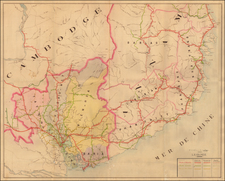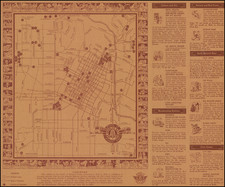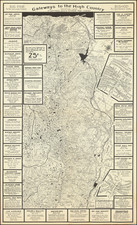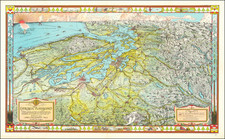Decorative example of this iconic Lucien Boucher image, extra embellished with the title section cut out and replaced by a printed example of artist Tyra Kleen's watercolor of a Javanese Dancer in a Seated Pose.
Designed by Lucien Boucher (1889–1971 and printed in Paris by Perceval for "l'association pour l'Indochine française" the map presents a united and unpartitioned vision of French Indochina, painted in a palette of red on yellow, with prominent cities like Hanoi and Phnom Penh clearly marked. Boucher's portrayal of the region, undivided by internal borders, is an idyllic and harmonious one, seemingly unaffected by the recent turmoil of World War II.
Despite the serene representation, the only hint of conflict is the depiction of a battleship in the South China Sea, a solitary nod to the recent Japanese occupation. The map otherwise focuses on the tranquility and natural bounty of the land. Boucher brings to life the diverse wildlife with intricate vignettes of elephants, snakes, monkeys, deer, tigers, and leopards. The map not only celebrates the fauna but also the economic activities and natural resources of the region, including scenes of rice planting, farming, logging, and mining.
Cultural and historical richness is captured through small but detailed illustrations of the majestic archaeological sites such as the temple ruins of Cambodia's Angkor Wat, Kampong Cham, and the ancient Imperial City of Hué in Vietnam. The surrounding seas are animated with oriental junks and fishing vessels among the lively sea life, including fish, turtles, and even a mythical sea creature.
The artistic composition is masterfully balanced with a large, ornate compass rose in the upper right, which mirrors the intricate title cartouche on the lower left. These elements, along with the oriental motifs and decorations, further accentuate the exotic allure and commercial appeal of the region, making Boucher's work not just a map but a celebration of French Indochina's indigenous culture and valued economic potential.
Lucien Boucher (1889-1971) was a French artist whose work spanned various mediums including cartooning, painting, and illustration. Born in Chartres and educated at the École de Céramique de Sèvres, Boucher initially focused on ceramics before World War I significantly altered his artistic trajectory. His period of captivity as a prisoner of war during the conflict led him to discover and hone his skills in drawing, thereby shaping his future career.
Before the war, Boucher had already begun to make a name for himself in the French art scene, particularly through his cartoons published in the weekly magazine "Le Rire." His early works demonstrated his capability for visual satire, but his subsequent experience in the war led to a more serious engagement with themes and subjects. After his return, Boucher navigated toward commercial illustration and poster design, successfully integrating his artistic sensibilities with the needs of the market.
Starting in the 1920s, Boucher began to produce a series of posters that drew inspiration from the surrealism movement. This work culminated in his most well-known project: a series of planispheric and celestial maps designed for Air France. These maps served a dual purpose. While they were essentially utilitarian, providing navigational information, they were also aesthetically innovative. Boucher employed elements of surrealism to add layers of meaning, transforming what could have been straightforward maps into more complex visual narratives.
Boucher's work with Air France solidified his reputation as an artist who could balance commercial needs with artistic innovation. His approach to map-making was characterized by a careful attention to detail, a strong sense of composition, and a willingness to explore the boundaries of the medium. While his maps were intended to serve a practical function, they also succeeded in capturing the public's imagination, offering a vision of travel that was aspirational yet grounded in geographical realities.









![[Texas Centennial Exposition]](https://storage.googleapis.com/raremaps/img/small/76381.jpg)
![[Berkeley] This Is The Map of Berkeley Town Its Streets Go Winding Up & Down An Oak-Covered Campus It Wears For A Crown With People & Places of Renown](https://storage.googleapis.com/raremaps/img/small/97201.jpg)



